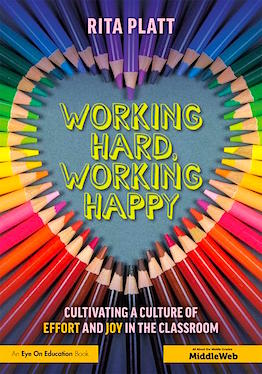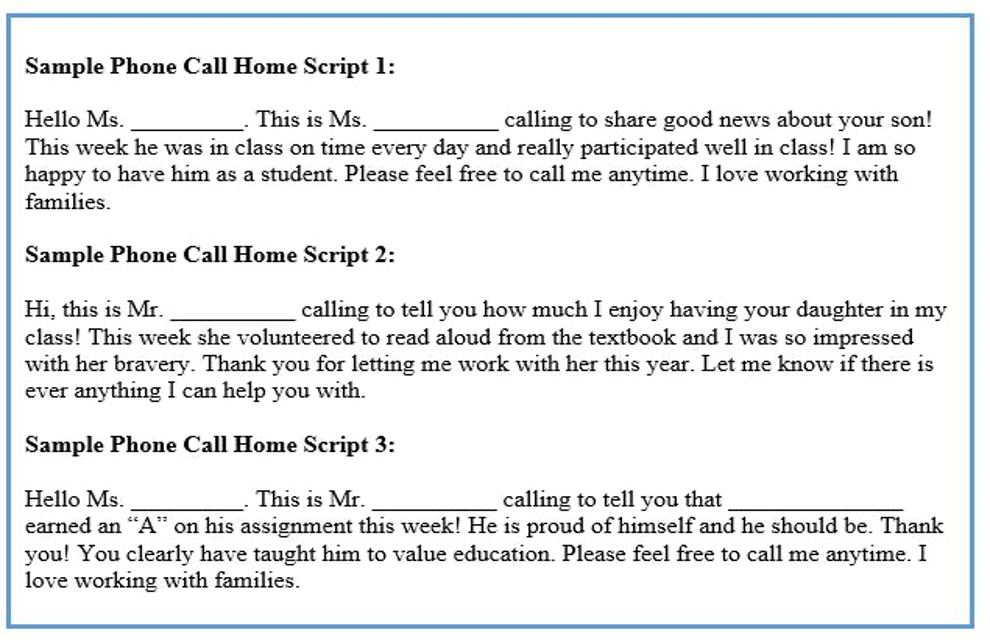Calling Kids’ Folks to Share Good News
A MiddleWeb Blog

There were many great answers that ranged from interactive smart boards to Chromebooks to online lesson plan websites. Those are really helpful to be sure. But, after thinking about it, I decided that for my money, the most important piece of technology I use is my cell phone.
Building Connections
As an educator I like my cell phone for the same reason I like it in my personal life. It helps me stay connected. With my mobile phone tech I can contact families and the community at a moment’s notice to celebrate successes and build rapport.
Relationships matter in teaching and learning! In fact, it may be the thing that matters most. If you want to build relationships, a good way to start is by reaching out with good news.
Honestly, right now, in this crazy COVID age of teaching and learning, simple connections mean more than ever before.
We are using more technology in our teaching to be sure. We are using learning management systems and have online grading systems, we are Zooming and Google Meeting, and we are using Kahoot, Nearpod, SeeSaw, Socrative and dozens more.
But despite all these digital pony tricks, during these times many students, teachers, and families are still feeling lonely and out of touch at times. Picking up your phone to make a personal connection, one-on-one style, might make a big difference.
Positive Phone Calls/Texts/Messages
When we have “regular” face-to-face school, I try to call at least two families per week. When circumstances permit, I do that right in front of my students.
If someone does something great, I’ll pull out my phone and ask the kid to dial his mom or dad’s number. Then, right in front of everyone, I will sing his praises. The students love it, and all ask if I can call their mom or dad next! It is really motivating.
I get lots of return calls, texts and emails from parents telling me how happy it made them. Later in the year, when I sometimes have to call to share not-so-good news, I think the parents are more receptive to me because they know I care. It is totally worth the extra effort in the long run.
Take Happy Notes
Observe your kiddos as they work and jot down any positives you notice.

✻ Did someone get to class right on time or always come prepared?
✻ Did a student ask a good question?
✻ Did you catch one of your students helping a classmate?
✻ Did the student finish an assignment on time?
✻ Did a youngster earn an ‘A’ on a difficult project?
✻ Did someone make great growth on an assessment?
✻ Did one of your readers finish a challenging book?
✻ Did a kid tell you a funny story?
An added benefit in calling to share good news is that if or when you need to call to ask for support, to remind, to share a negative consequence a student has earned, parents are more likely to answer the phone and listen to you. Positive phone calls breed positive feelings. Positive feelings are like money in the bank.
During Distance Learning Times
When we are involved in distance and hybrid learning, the same principles apply – only the topics to spur a phone call can be even more broad. In addition to the above reasons to call, try these opening lines:
✻ Hi! I’m just calling to check how things are going. Is ________________ understanding the lessons?
✻ I miss _________________! I hope s/he’s doing well! I thought I’d call and say hi to you and ________________ just to check in.
✻ Hello, this is Mr./Ms. ____________________. I am calling to tell you that I was really impressed with __________________’s participation in our Zoom meeting!
✻ Hi there! I am calling to let you know that __________________ has all of her/his work turned it. That’s great! Keeping up during distance learning can be extra challenging.
From a Parent’s Perspective
I am the mother to a son fresh out of middle school and a daughter midway through high school. They are as busy as I am, and we often feel we’re rushing around like circus clowns. We are so busy with chores, work, sports, pets, and family fun that I am often left wondering what is happening at school for them. If I ask them about it, they’ll respond, though never in detail.
I go to parent-teacher conferences at their schools (old normal), but those only happen twice a year and the lines to see teachers are really long. What our schools promote as best for keeping up-to-date on how our children are doing is to look the PowerSchool platform we use. But when I look at PowerSchool, I generally find little useful information there. In pandemic times, we may have conferences online, but they can still be pretty brief and formal.
I am a school principal in the district where my kids attend school, and I don’t often get communications about my children. If I don’t, who does? Not enough parents. Now, you may be thinking it’s not your responsibility to reach out to parents, it’s their responsibility to reach out to you. You may think, I don’t have time to reach out to all of them. I get that. Especially now.
The first year I worked on making positive contacts, I was teaching and had 179 students. It took a long time to share something kind with all of their parents. But I did it and it was worth it. It was worth it to each parent who loves their children as much as I love mine. And, in the long-run, it was worth it to me to help parents think of me as on their side. (And I am. I’m on everyone’s side.)
What to Say?
If you choose to call, but are unsure of what to say, try using the ideas above. You might also find the scripts below helpful, and they work whether we are teaching onsite, at a distance, or both. If you get voice mail, no problem, leave an upbeat message with instructions for how to reach you.
Maybe a Text Is Better?
Of course, your communication doesn’t have to be a call. In fact, I realize that these days, phone calls aren’t the norm in person-to-person communication. My sister, who is only three years younger than me (we’re solidly middle aged), hates it when I call. She is a texter and promises that almost everyone else is too. Whenever I call her on the phone she says, “What is it, 1980 again?”
As the gap between my age and the age of the parents of my students widens, I am finding that texting or messaging works just as well as phone calls and in some ways better!
For example, I love snapping a picture of a student just after she said something funny and sending it to her parents with a short text about the joke. Sometimes, I take “silly selfies” with kids just for fun and we text parents with the picture of us making goofy faces. It takes a half a minute to do, but parents and students alike really love it.
Set a Goal!
Last year, pre-Covid, a teacher in my building included positive contacts as a part of his Wisconsin Teacher Evaluation plan. He set it as a “professional practice goal,” and it had a really wonderful effect! Read his reflection below.
I was very aware of my goal this year. I kept records of which parents I contacted, when I contacted them, which mode I used to contact them and what the contact was about. Until the shutdown I was well on my way to achieving my goal. I was very pleasantly surprised to see the outpouring of gratitude from parents when I contacted them for no other reason than to point out all of the things their kids were doing well and how much I appreciated having them in class.
The parents REALLY appreciated this. It might be something we could do school wide in the years to come. Since the shutdown, I have had a minimum of 3 contacts with each family every week. On Mondays I email each family explaining the week’s important messages and inviting them to the week’s Zoom meeting. On Wednesday we have classroom Zoom meetings, and I call each parent once each week to answer any questions they may have and to just check in to see how they are doing.
Make it a goal to call or text two to five families a week to share kind words about your students. Yes, it takes time, but it is worth every minute spent and it doesn’t have to be done in one day, one week, or even one month.
Once you have something specific and positive to share, start by calling the families of students who may have had phone calls home in the past for doing something wrong. Make sure you tell the students when you call or text their parents. You may be surprised to learn how much it means, to even your seemingly toughest kids, to learn that you care enough to call.

































